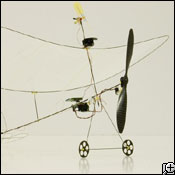 A group of scientists at the Swiss Federal Institute of Technology are working on yet another ultralight flying machine. The robot, currently with a 14" wingspan, is designed to fly around in indoor environment. Such environments present special problems for navigation.The researchers are trying to have the robot act like a house-fly in avoiding obstacles.
A group of scientists at the Swiss Federal Institute of Technology are working on yet another ultralight flying machine. The robot, currently with a 14" wingspan, is designed to fly around in indoor environment. Such environments present special problems for navigation.The researchers are trying to have the robot act like a house-fly in avoiding obstacles. A fly navigates using its large, compound eyes, which let it see almost an entire field of view at once. Their optic lobes contain motion-sensitive neurons that respond to images moving across the retinas.
Those moving images, the so-called optic flow, combine data that the insect perceives as it flies straight, and data it senses from other motions such as turning, bobbing, or tilting side to side.
Those moving images, the so-called optic flow, combine data that the insect perceives as it flies straight, and data it senses from other motions such as turning, bobbing, or tilting side to side.
Apparently, flies tend to fly in straight lines until they encounter an obstacle, then they make a sharp 90 degree turn and continue. The scientists on the project tried to emulate this behavior by placing two cameras on the robot's wings and maintain stability using a tiny gyroscope.
In the latest test, the robot was capable of navigating autonomously in a 7 meter x 7 meter room for up to 5 minutes straight.
Cornell is also working on tiny flying robots, along with Epson.

0 Comments:
Post a Comment
<< Home